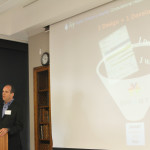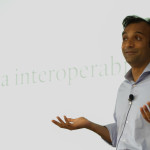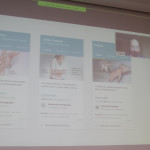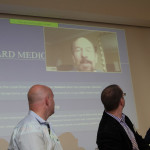[jwplayer player=”1″ playlistid=”6201″]
Getting SMARTer. The Boston Children’s Hospital Computational Health Informatics Program and the new Department of Biomedical Informatics at Harvard Medical School held an invitation-only meeting on developing a national Health Information Technology Platform supporting Substitutable Apps (loosely, an “App Store for Health”) on June 11-12, 2015.Renowned surgeon and writer Atul Gawande and U.S. Chief Technology Officer, DJ Patil, keynoted.One hundred leaders from across the health care, technology, and government sectors came together to identify barriers to innovation at the point of care; to unlock how to proceed with an apps-based model; to figure out the key antecedents to ensuring that an app written once will run anywhere; and to spark the community of software developers to innovate on the platform that interfaces with the full spectrum of health system data.We introduced the idea of a health information technology platform in a 2009 paper in the New England Journal of Medicine,” No Small Change for the Health Information Economy,” suggesting that electronic medical record systems should look a lot more like an iPhone than they currently do. The iPhone and Android platforms separate the system from the functionality provided by the applications. And the applications are substitutable: a consumer can download a calendar reminder system, reject it, and download another one instead. The consumer is committed to the platform, but the applications compete on value and cost. The platform approach to software design, relying on an application programming interface (API), can be used to create and support an extensible ecosystem of applications and to stimulate a market for competition on value and price.
With a grant of $15 million from HHS, we have developed a model for such a system—the open source and open standards SMART Health IT, described in technical detail here, from which we have learned important lessons about the technical, regulatory, and business implications of this transformative and rapidly evolving trend. Recently, with demonstrated successes of SMART and emergence of the FHIR standard to support EMR and HIT APIs, it has become feasible to expect a national-scale infrastructure based on “substitutable” components to drive down health care technology costs, allow flexibility, support standards evolution, accommodate differences in care workflow, foster competition in the market, and accelerate innovation.
The meeting continued the work begun six years ago at the first ITdotHealth meeting. On the tail end of an historic $48 billion dollar federal investment in HIT, we look forward to leveraging that infrastructure to support a flexible, nimble health system in a state of constant learning and improvement. The extraordinary group of participants at ITdotHealth III “Getting SMARTer” continued to drive the national conversation.
Clicking on a photo will open a carousel of enlargements. Click the “X” in the top left of the carousel to return to this page. (Photos courtesy of Rachel Ramoni)






























































































































































































































































You must be logged in to post a comment.